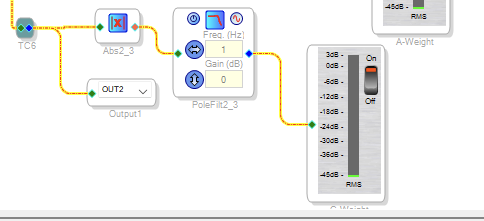Let's say we have a white noise as input. Total RMS value is -20dBFS.
When I apply a parametric filter at 250Hz with Q = 4 at 3dB boost, what will be the final total RMS of the signal? How can I calculate that?
Is it same with the shelvings?
I have IIR coefficients of filters and an Excel table that plots the transfer function with given BW resolution. Standart dB summation formula looks like not correct.
Also an additional question. In BW equations, corner frequencies are stated as 3dB lower that the center frequency. But when I apply a 1/3 BWn parametric eq with 5dB gain, corner frequencies are about 2,35dB. What is that I'm missing?
EDIT BASED ON HILMAR'S ANSWER
Firstly I've run a whitenoise into ADAU1772 devboard. I'm monitoring signal as this;
When I apply eq with huge boosts like 10dB, 20dB; result changes only 1-2dB (frequency below 1kHz). When fc of the eq is above 10kHz, changes are shown more alike.
@Hilmar; since I've not enough knowledge in signal processing equations, I'm having trouble to implement the equation. In third Pg equation, I understand that, I will sum every sample of the filter gain^2, but not in dB, as in linear value? And will divide that into sample count? It looks like dB average formula.
I've tried in my excel with 100Hz, Q= 1,414214, Boost = 3dB; 501 samples (10Hz-23kHz; BWn~1/30)
Step 1: Calculated all samples linear value^2; $=(10^{Bant1_dB/10})^2$
Step 2: Sum(all above) Step 3: Divide result to 501 (sample count)
Result is; 1,26. I convert it to dB again with 10*LOG10(1,26), so It looks like 1,01dB. Is this ok?
I changed the Q to 0,1, and the result is 2,48(linear); 3,95dB.
And how is input signal is important? Isn't that to total added gain of the transfer function?
EDIT FOR CLARIFICATION OF THE QUESTION
For a usage example; my gain structure is transmitting 0dBu analog signal from DSP to power amplifier in pink noise. After some equalizer filters (i.e. for room tuning), I'll boost or cut some bands. So I need to calculate new signal level in dBu to re-arrange my gain structure.
EDIT 3: RESULTS BASED ON TESTS
I had to edit the formula as below, because 3dB offset gain (0dB boost) has the result of 6dB Power Gain. So I just rearrange dB to linear conversation from $10^{H/10}$ to $10^{H/20}$ .
On the transfer function array, I used formula below;
=10*LOG10(SUM(IF(ISNUMBER(Table4[Band 1]);(10^(Table4[Band 1]/20))^2))/COUNT(Table4[Band 1]))
As a conclusion; is this power gain the parameter what i need to add dBu output of the DSP? (If my calculations are correct.)
Last one is: Are there any other formula to calculate this power gain without sampling the transfer function, just to use frequency, filter type, Q and boost?
So here is some of the results I get with given values in the screenshots;








filternormcalculates $\ell_2$ norm which is square root of the filter energy. The relationship between power and energy yields the division by sample count (time). $\endgroup$